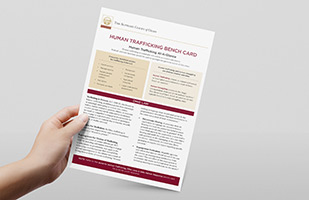Bench Card Offers Guidance on Human Trafficking Cases

A new reference guide helps educate courts on human trafficking laws.

A new reference guide helps educate courts on human trafficking laws.
The Ohio Supreme Court announced today the availability of a bench card to strengthen the response of courts to recognize the intersection between human trafficking, domestic violence, and sexual violence.
Human trafficking is modern-day slavery and involves the use of force, fraud, or coercion to obtain some type of labor or commercial sex act.
The reference guide, developed by the Supreme Court’s Domestic Violence Program, seeks to better educate the judicial branch on state laws that target human trafficking.
In 2017, the National Human Trafficking Hotline received 645 phone calls and identified 191 cases in Ohio.
It’s a current and relevant issue for municipal and common pleas courts, which come into contact with traffickers and victims charged with criminal activities often associated with their trafficking.
The guide provides practical tips for judicial officers, as well as highlights red flags compiled from the literature and practitioners’ experience with traffickers and victims.
The reference guide complements other efforts to shed light on the complexities of human trafficking.
In February 2017, the Ohio Supreme Court — through the leadership of the Children and Families Section and its Advisory Committee on Children and Families — released Juvenile Human Trafficking, Ohio Laws & Safe Harbor Response to focus attention on the number of children who are becoming systems-involved due to trafficking, and Juvenile Court Trauma-Informed Practices to appropriately identify and manage juvenile human trafficking cases.
January is National Slavery and Human Trafficking Prevention month.
Acrobat Reader is a trademark of Adobe Systems Incorporated.


